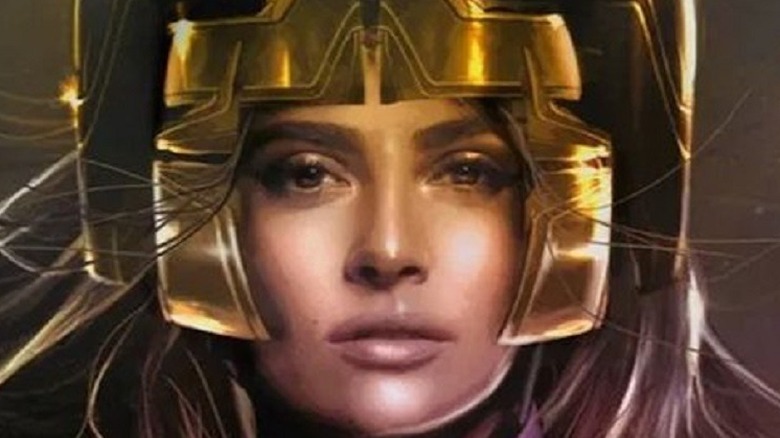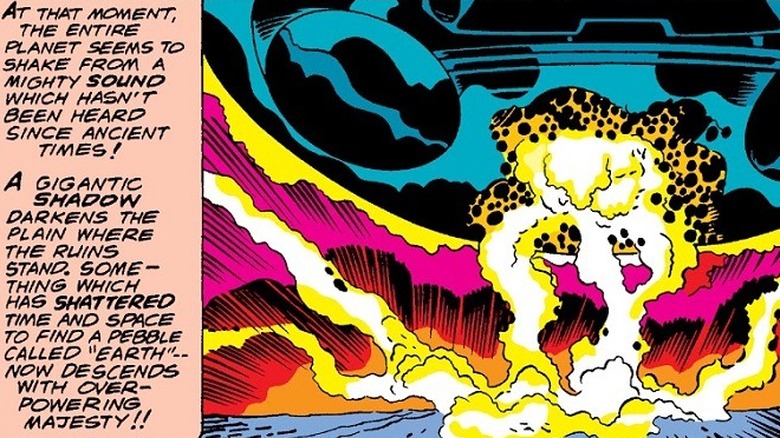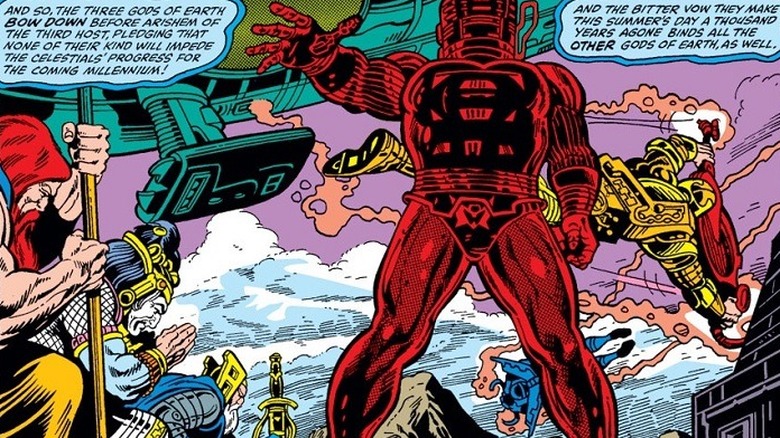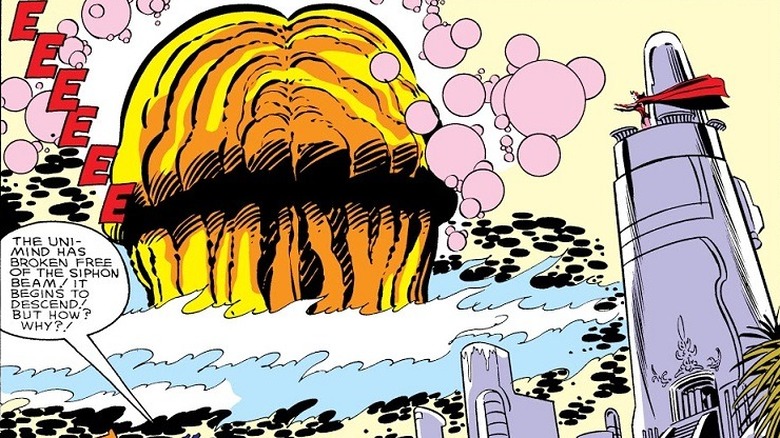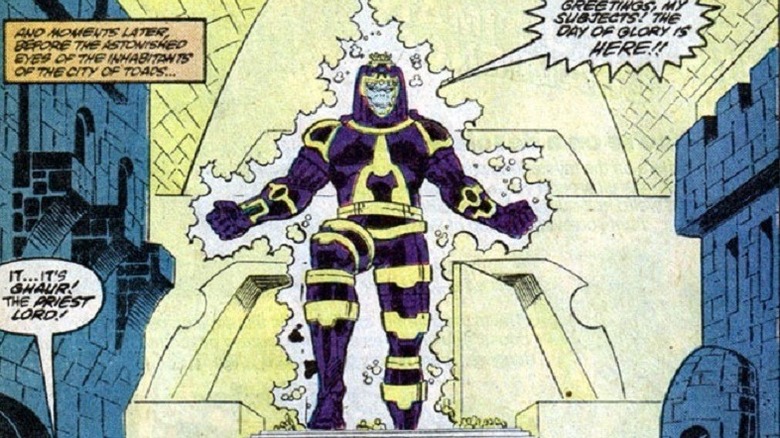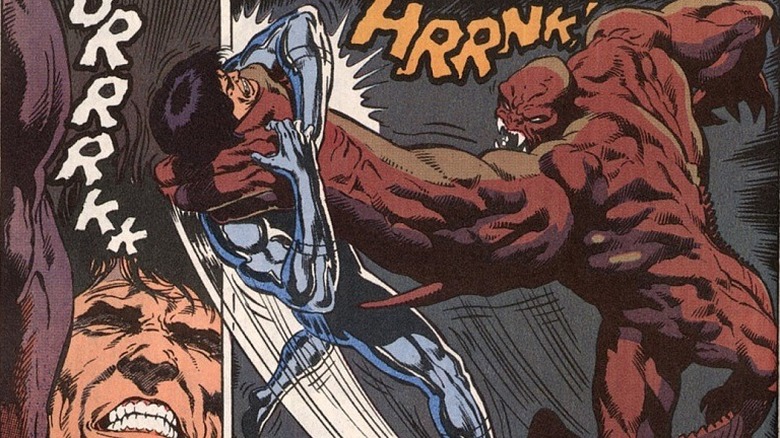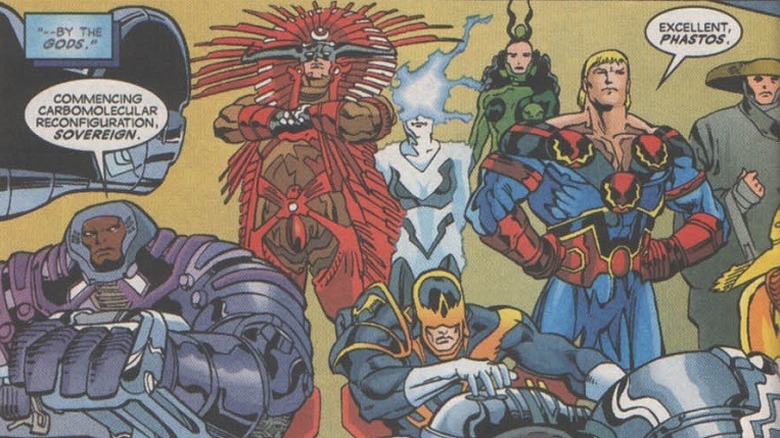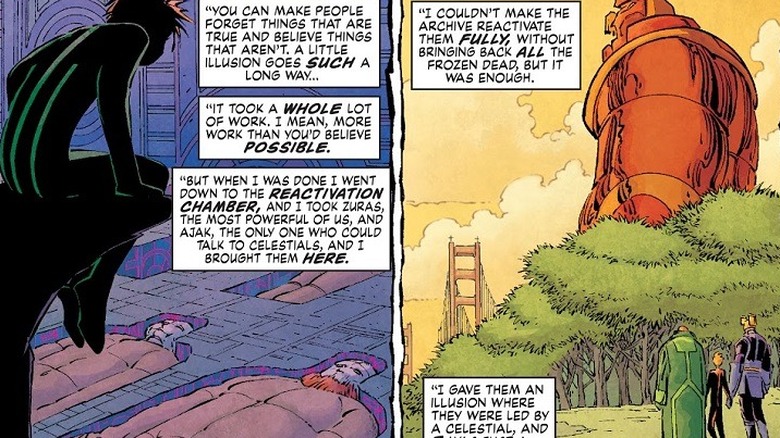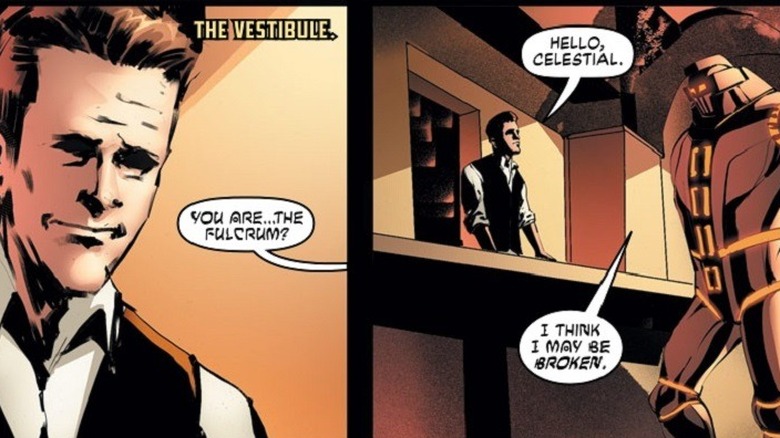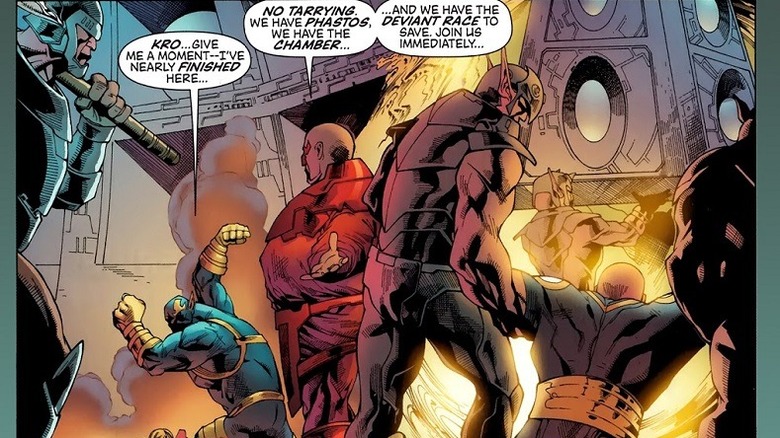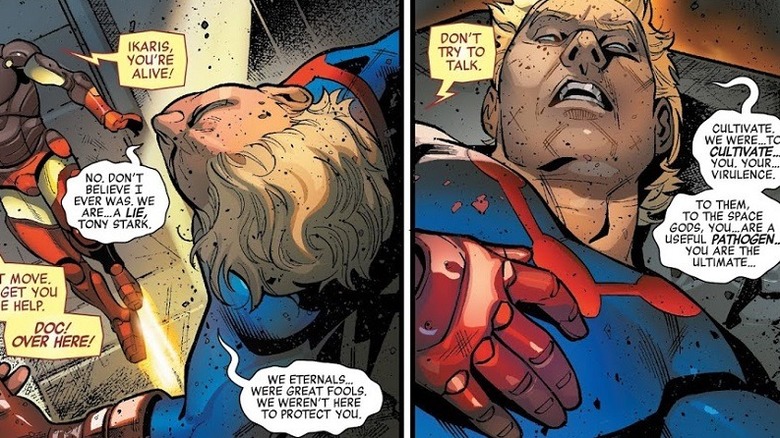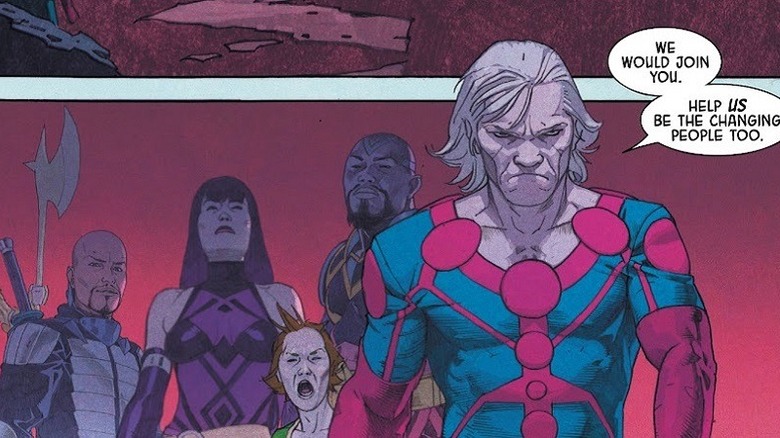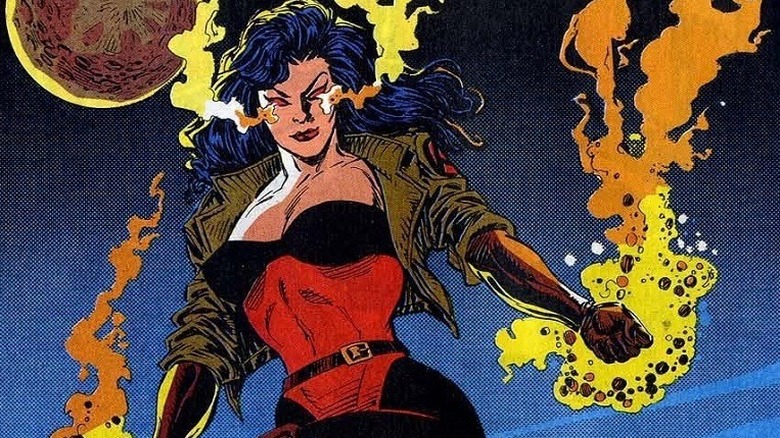Comics You Need To Read Before The Eternals
We may receive a commission on purchases made from links.
Let it never be said that Marvel isn't willing to take risks. The newest phase of the MCU has the world's most popular movie franchise digging deep into its roster of characters in an effort to tell fresh, new stories that will eventually lead to new, refreshed Avengers adventures.
But "The Eternals" may be Marvel's boldest risk since they released "Guardians Of The Galaxy," a film that featured an array of obscure characters, yet nonetheless captured the imagination of audiences and became a blockbuster series. "The Eternals" is heady stuff, a film about a hidden race of immortal, god-like beings blended in with the rest of humanity who emerge to deal with an apocalyptic event. It's quite a hook, but what if a reader wants to brush up on these characters in preparation before seeing the movie?
Fortunately, the Eternals have been in relatively few comics, despite being around for 45 years — making it relatively easy for a reader to catch up with all their major appearances. Despite their original series having only lasted 18 issues and an annual, the Eternals and the mythology around them have become cornerstones of the Marvel universe — and they've been teased in the Marvel Cinematic Universe as well. From the first unveiling of the Celestials in "Guardians Of The Galaxy" to Ego's introduction as a Celestial in "Guardians Of The Galaxy Vol 2," Marvel was laying = the foundation for a greater exploration of these Eternals — as well as their masters (the Celestials) and their enemies (the Deviants).
Feeling a bit overwhelmed? Let's take a definitive look at the comics you should read to put yourself in the ideal mindset before seeing "The Eternals."
Introducing the Eternals
The Eternals were created by Jack Kirby during his fertile-but-strange return to Marvel in the '70s. In addition to stints writing and drawing his creations Captain America and the Black Panther, he also introduced new characters like Machine Man and the Eternals.
"The Eternals" #1 debuted in July of 1976, introducing readers to the concepts of the Eternals, the Deviants, and the Celestials. The latter were space gods coming to Earth to judge whether or not its inhabitants deserved to live. They created the Eternals to be their servants: few in number, immortal, and extremely hard to kill. Throughout history, they were often mistaken for the gods of Earth's mythology. The Deviants were another evolutionary offshoot of what would become humanity — only their genetic code was unstable, creating rapid, horrifying mutations.
The entire run was reprinted in "The Eternals by Jack Kirby: The Complete Collection, but the first 13 issues are the most important. They introduce noble Ikaris, flighty Sersi, the wisecracking speedster Makkari, Celestial go-between Ajak, mischievous Sprite, scheming Druig, and their leader Zuras. The Deviant Warlord Kro is introduced, as is his long, complicated relationship with the icily-intense Eternal Thena.
In these stories, the Deviants tried to pit humanity against the Celestials and later had their headquarters in Lemuria destroyed by one of the Celestials. The Eternals made themselves known to certain humans, including the archaeologist Daniel Damian and his daughter Margo.
Thor and the Eternals
"Thor Annual" #7 was the first appearance of the Eternals in a neighboring Marvel comic. In it, Thor regains memories of meeting the Eternals ages earlier, learning that Valkin of the Eternals wiped his mind of it. That sets off a chain of events resulting in an epic battle with the Celestial host and their ultimate judgment of Earth. Collected in "Thor And The Eternals: The Celestials Saga," it includes the aforementioned Annual as well as 'Thor" 283-301.
When Thor attempts to confront the Celestial host and accelerate what was supposed to be a fifty-year judgement period, the Celestial Arishem the Judge shows Thor an image of Odin, Zeus, and other gods bending their knee in fealty to the Celestials. An outraged Thunder God goes on a quest for knowledge and learns about the true purpose of the Destroyer, the Oversword of Asgard, and many other secret activities that his father Odin was up to.
In the end, Odin and the Eternals battle the Celestials, Thor manages to knock Arishem off his feet, and yet the Celestials barely flinch. Only a stunning, last-second appearance by Thor's true mother saves the day and sends the Celestials on their way.
The Eternals make a decision
The Eternals next appeared as captives of the Deviant elite in "Iron Man Annual" Vol 1, #6, collected in "Iron Man Epic Collection: Duel Of Iron." Once again, Kro's weakness for Thena eventually allowed her to summon Iron Man (then Jim Rhodes) to help her and the Eternals escape and reduce the Deviants to their base matter and shoot them off into space.
The Eternals returned in "Avengers" #246-248, collected in "Avengers: Absolute Vision." Having survived the Deviants' attack, the Eternals called on everyone to join them for their sacred Uni-Mind ceremony. This brought every Eternal together to form a single consciousness, which they often did when significant decisions needed to be made. The Avengers accidentally got swept up into this event when the Wasp and Eros were at one of Sersi's parties, and the Eternals sent the Delphan Brothers to retrieve her.
The Avengers had to save the Eternals from the villainous half-Deviant Maelstrom, whose energy-absorbing abilities nearly allowed him to absorb the power of the Uni-Mind. The Vision came up with a scheme to defeat him, and most of the Eternals decided to leave Earth in search of their destiny. Ikaris, Thena, Sersi and a few others opted to stay behind.
All of these comics can also be found in "Eternals: The Dreaming Celestial Saga."
Lord Ghaur schemes
The next major appearance of the Eternals was in a 12-issue miniseries that debuted in 1985. This was collected in "Eternals: The Dreaming Celestial Saga." This miniseries proved to be every bit as important to the overall mythology of the Eternals as the first Jack Kirby volume, for a number of reasons. Phastos, Khoryphos, and Kingo were introduced in it, for starters. More importantly, the Deviant priest Lord Ghaur was introduced as the primary antagonist to both the Eternals (and Ikaris in particular) as well as Warlord Kro.
Kro gets an in-depth character study in the series as someone who desires power and wants to rule the Deviants, but his long life (as long as an Eternal's) gives him a perspective the other Deviants lack. His complicated affair with Thena gets even more complicated when he realizes that Ghaur is scheming against him, and he secretly bends Thena to his will.
Ghaur reveals a horrible secret about the Deviants: their supposed culling of the mutates in their species to preserve racial integrity was simply a plot on his part to have what amounted to a zombie Deviant army to do his bidding once he achieved his scheme. That scheme involved finding and absorbing the essence of the Dreaming Celestial. This was a renegade Celestial that rebelled against his brethren, and they locked him away beneath the Earth as a punishment. Ghaur nearly accidentally unleashed him before he was defeated.
The Herod Factor
Next in the story of the Eternals came the one-shot comic "The Eternals: The Herod Factor." It began with a monster killing twin boys and girls for no discernible reason. Soon, Thena realized someone knew her secret: that she and Kro had conceived two children. Even Kro didn't know. Thena was able to pass on the pregnancy to a human who desired to get pregnant, and her children grew up seemingly normal and happy.
Thena realized that someone was trying to kill her children and revealed herself to them. Though stunned, they allowed her to take them to the Eternals' home in Olympia, where Thena thought they'd be safe. She was wrong. The monster tracked them there and overwhelmed two powerful allies in the Deviant exiles Karkas and Ransak the Reject.
Eventually, Ikaris deduced that the monster was being controlled by someone who had an axe to grind against the Eternals: Daniel Damian. He warped and transformed Ajak into doing his bidding in an effort to get revenge on the Eternals for the accidental death of his daughter. He also fooled the Eternals and Deviants into thinking there was a prophecy regarding them trying to rule the world. In the end, Thena called on Kro for help and told them about their children. Kro accepted them with open arms.
Apocalypse Now
Published in 2000, the one shot "Eternals: Apocalypse Now" aimed to set up a new direction for the Eternals. It began with the ancient mutant Apocalypse trying to start a war between humans and Deviants in order to keep mutants ascendant.
Ikaris summoned a number of Eternals to help him investigate the attack, including several introduced here: Chi Demon, Aurelle, Psykos, and Ceyote. Ikaris did something unusual for an Eternal, gathering these Eternals to help in the belief that humanity needed protection from the Deviants and other threats. He did this with the disapproval of his father, who preached the doctrine of non-interference that the Eternals had followed for so long.
Apocalypse then horribly transformed the Deviant mutates (and Eternals allies) Karkas and Ransak the Reject. Ransak was saved by the Eternals and returned to his original form, but Karkas was used by Apocalypse as a pawn. Along with many other Deviants, he was mind-controlled and ordered to rampage through San Francisco. Ikaris tracked Apocalypse to a satellite and battled him there, with both noting that this wasn't the first time they had met. Ransak freed Karkas from his bondage.
Ikaris then met with the press and declared this group a new superhero team called the New Breed. He was Sovereign, Sersi was Mezmer, Thena was Corona, Phastos was Ceasefire, Psykos was Psyche, Ceyote was Tomorrow Hawk, and Ransak was Warhead. Oddly enough, the team was never spoken of again.
Sprite's ultimate prank
The big-time comics duo of Neil Gaiman and John Romita, Jr. took the reins of the third volume of the Eternals. It was just a seven-issue miniseries, but a lot of significant events occurred. It was collected as "The Eternals by Neil Gaiman" and rebooted the group in ways that would have long-lasting effects. The series had a perplexing start, as the reader was introduced to people who were clearly the Eternals, only they had completely forgotten their own identities. Sersi was a party girl. Thena was a scientist and a mother. Makkari was an EMT. Zuras was a homeless man, living in an alley. Druig was a government functionary for a former Soviet republic.
Ikaris remembered who he was, however. He started trying to convince Makkari and Sersi as well, urging them to remember. He suspected that the Deviants had somehow erased their memories. The reality was much darker. Sprite was an Eternal who was engineered by the Celestials to never get older than eleven years old — a trickster who often played nasty pranks on humanity as well as his fellow Eternals.
Well, after several million years, he was tired of being eleven. He quietly regenerated Zuras and Ajak (both of whom had died) and used them to form a Uni-Mind with the Dreaming Celestial. This gave him enormous power, and he used it to become human while wiping the Eternals' memories. For his last trick, he woke up the Dreaming Celestial.
Resisting the Horde
The events in Gaiman's series were immediately followed by "Eternals" Volume 4. Issues 1-6 were collected in "Eternals: To Slay A God" and issues 7-9 and an Annual were collected in "Eternals: Manifest Destiny." After the Dreaming Celestial was awakened, he chose to observe the Earth instead of destroying it immediately. He used Makkari as his go-between.
Sersi and Makkari had fallen back in love upon being reawakened. The Deviants worshipped Makkari, since he was the Dreaming Celestial's representative, and he revealed something horrifying: the Celestials bred the Deviants to be food. When Makkari was killed by a jealous Ajak, the Dreaming Celestial's programming kicked in to destroy Earth. Sersi sacrificed herself to recreate Makkari, who shut down the Dreaming Celestial.
After her sacrifice, Sersi wound up in a mysterious cosmic bar, hearing tales of various beings who had been destroyed by the Horde: servants of a cosmic entity called the Fulcrum. The smiling bartender, named Jack, encouraged her to have a good time before she either returned to Earth or moved on.
Meanwhile, Druig was plotting to conquer the world, opposed by Ikaris. They had a massive battle, but Ikaris, aided by the X-Men triumphed. That victory was short-lived, as the cosmic scavengers known as the Horde had been summoned by their mole: Thena's son Joey. The Dreaming Celestial challenged the Fulcrum (the bartender) and begged him to spare Earth. The Fulcrum agreed, having waited for eons for one of his creations to develop free will.
Warlord Kro and the fate of the Deviants
The Deviants lacked the Eternals' immortality and the genetic stability of humans, but their huge advantage was their ability to breed quickly. In "Thor: The Deviants Saga," Warlord Kro desperately sought a solution to a crisis: the Deviant males had become sterile. Pitting his resurrected enemy Ghaur against the upstart Ereshkigal, he kidnapped Phastos and took an Eternal reactivation chamber in an effort to kick-start the Deviants' survival.
The wild card in all of this was Ereshkigal stealing an artifact from the ruins of Asgard: the Unbinding Stone. Brought to Asgard by an inter-dimensional visitor who created a cosmic rift, he revealed that it annihilated everything on an atomic level, unmaking all the laws of physics. Odin decided to keep it over Thor's protestations, and Ereskhigal had no clue what she was doing.
Phastos knew what he was doing, as he had the Deviants collect Antarctic vibranium for him. This anti-metal substance was capable of destroying adamantium, and he thought it could destroy the metallic Unbinding Stone as well. It was almost too late, as a power-mad Kro and Ereskhigal activated the Stone, but Thor took the vibranium and managed to destroy it. The Eternals, who had been in space, returned to Earth. Ikaris told Thor there were serious matters the Eternals had to discuss, and they were isolating themselves from humanity again. Except for Phastos, who stayed with the Deviants (and a repentant Kro) in order to cure them.
Eternals and cosmic suicide
In "Avengers" Volume 8 #4, the Eternals learned a dark truth that drove them insane. This was collected in "Avengers: The Final Host." The Dreaming Celestial had already revealed that the Deviants were bred as food. What the Eternals learned is that rather than being designed by the Celestials to be humanity's defenders, they were instead the Celestials' lab techs. Humans were allowed to survive only because the Celestials sensed antibodies in them that could be used to combat their enemies the Horde, against whom they were otherwise helpless.
When they learned this, the Eternals turned on one another, killing each other when they weren't simply committing suicide. The Avengers learned that Earth had been the resting place of the Progenitor, an ancient Celestial infected by the Horde. He infected a Celestial looking for him named Zgreb, who formed a group of Dark Celestials that wiped out the rest of their race. Loki summoned the Dark Celestials to Earth for the Final Host in order to destroy it, as the Horde swarmed over it.
Ikaris was right about humanity's resistance to the Horde. Before he died, he passed on to Iron Man the Eternals' greatest weapon: the ability to form a Uni-Mind. In that state, they deactivated the Horde, resurrected the dead Celestials, and defeated the Dark Celestials, saving Earth.
The Eternals face a new era
The newest ongoing "Eternals" series, Volume 5, resurrected the Eternals into a form that's much closer to the characters in the movie. For example, Sprite is female in the film, and Sprite's new body in the series is also that of a girl. The first six issues have been collected as "Eternals: Only Death Is Eternal." Ikaris was the final Eternal to be reborn, but immediate problems arose. Someone murdered Zuras and then shut down the resurrection machines.
Ikaris and Sprite discover Thanos on a rampage. Thanos is an Eternal himself, the son of A'Lars, Zuras' brother, who left Earth for Titan. A traitor is suspected because Thanos gained access to Eternal transportation systems that required inside help. Thena was the prime suspect because of a quarrel she had with Zuras. The Forgotten One was another suspect, but he had no interest in stopping the Eternals' "machine" that kept Earth going.
Eventually, Phastos revealed that he learned something horrible: every time an Eternal was resurrected, a human life was snuffed out in order to make it happen. He killed Zuras and sabotaged his own handiwork in order to stop it. He even resurrected Thanos in order to make him do his bidding in the mission. Once found out, the Eternals decided to turn to the Deviants in order to figure out how to change and seek a new purpose, now that they no longer served the Celestials.
Eternal extra credit
Most of the Eternals' stories were contained to their own title, but there were exceptions. The most significant one is Sersi, who had a long stint as an Avenger.
The collection "Eternals: Sersi And The Avengers" includes the previously collected "Eternals" #4 and "Avengers" #246-248, as well as "Avengers" #308-310, 314-315, 360-361, and the "Black Knight: Exodus" one-shot. Sersi starts off as a party girl who enjoys flirting with the uptight Captain America, but becomes a much darker character when she joins the team full time. A love triangle develops between Sersi, Dane "The Black Knight" Whitman, and Crystal of the Inhumans. Just as Dane was going to declare his love for Crystal, he was bound to Sersi as her Gann Josin (life mate) against his will in an Eternals ceremony. Sersi was slowly being driven insane by a villain named Proctor, a version of Dane from another dimension who had been rejected by Sersi. Dane and Sersi wound up being torn through reality after defeating Proctor, until they eventually wound up in Earth's past and then finally returned to the present.
The Forgotten One also briefly became an Avenger, taking on an old alias: Gilgamesh. Several of those issues were collected in "Avengers by John Byrne Omnibus." He was also apparently killed in "Avengers" #391 that kicked off the Crossing storyline.
